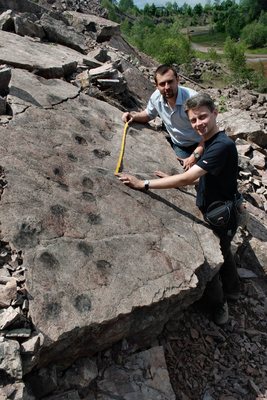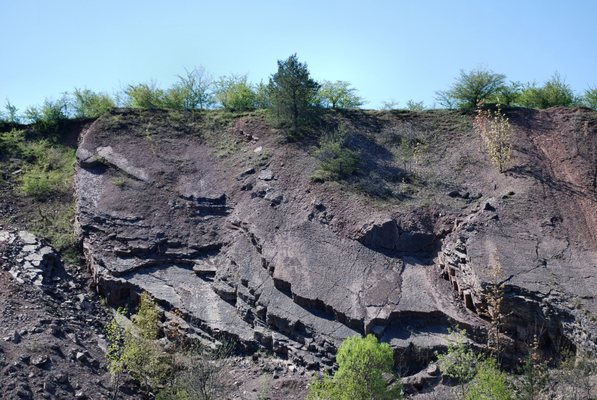
by Ian Randall Thursday, January 5, 2012

Piotr Szrek and Grzegorz Niedźwiedzki with tetrapod trackway. Photo by M. Hodbod

Zachelmie quarry, in Poland's Holy Cross Mountains. PHoto by G. Niedźwiedzki
About 18 million years earlier than they were thought to exist, tetrapods — vertebrates with four limbs instead of fins — walked in what is today Poland. A new study published in Nature describes tracks belonging to a tetrapod in a Polish tidal flat, dating to the Middle Devonian period, about 395 million years ago. The discovery may prompt scientists to completely reassess the environment, origins and timing of early tetrapods.
Much work has been done on the development of early tetrapods over the last decade. Tetrapod-like creatures called “elpistostegids,” which have paired fins that are thought to be the precursors to limbs with digits, are the tetrapods’ closest apparent relatives. Based on tetrapod fossils and trace footprints, scientists thought that the fish-to-tetrapod transition occurred rapidly, about 391 million to 385 million years ago, and in a brackish to freshwater setting. The transition, it was thought, occurred as a response to altered environmental conditions caused by the spread of tree-sized vegetation on land.
The discovery of the ancient tetrapod tracks, however, pushes back the date of the evolution of tetrapods, throwing both the temporal and environmental bases for this hypothesis into doubt. A team of scientists from Warsaw University found the tetrapod tracks in the Zachelmie quarry in Poland’s Holy Cross Mountains. The rocks that bear the tracks are shallow-water carbonate deposits, from the Wojciechowice Formation, and have been dated to 395 million years old, from the Eifelian stage of the middle Devonian.
Grzegorz Niedźwiedzki, a geologist at Warsaw University and lead author on the Nature paper, says he first observed the footprints in 2002. “I was not sure what it was but I knew it was biogenic, probably a footprint,” Niedźwiedzki says. “The problem was it looked like a Triassic reptile footprint and I was looking at a rock from the Middle Devonian,” he says. “This was confusing!”
The tracks, which were actually made by a tetrapod of about two meters in length, show the distinct impressions of individual digits with each step. The prints closely resemble tracks made by a Late Devonian tetrapod, Ichthyostega. Tetrapods were the only animals existing at the time that were capable of producing such tracks, the team noted in the study.
Indeed, the evidence “is quite clear — the imprints are very crisp,” says Philippe Janvier, a paleontologist at the Muséum National d'Histoire Naturelle in Paris, France, who was not involved in the study. “There is no doubt that it is a tetrapod.”
The tracks were made alongside carbonate deposits that show desiccation cracks and the impressions of raindrops — indicating a shallow tidal or lagoonal environment, the team reported. The location of the tracks within that kind of environment also changes ideas about where the tetrapods first stepped onto land, Niedźwiedzki says: Rather than transitioning from a freshwater environment, this discovery suggests it was a transition from a marine environment.
The tetrapods were probably submerged in water as they walked, the team said. If the creatures were partially floating, that would explain the absence of a central mark left by the body as it dragged along the sediment.
The next step for paleontologists is to look for evidence of tetrapods and their ancestors in sediments dating to the same or a slightly earlier time, Janvier says. The Emsian stage of the Middle Devonian, which occurs right before the Eifelian, at about 400 million years ago, has so far yielded few fossil vertebrates, he adds. “This is where, in the future, maybe evidence for tetrapod ancestors will be found.”
© 2008-2021. All rights reserved. Any copying, redistribution or retransmission of any of the contents of this service without the expressed written permission of the American Geosciences Institute is expressly prohibited. Click here for all copyright requests.